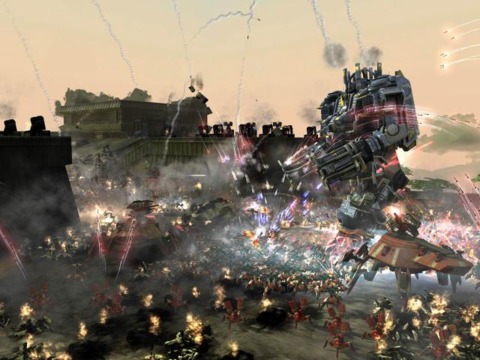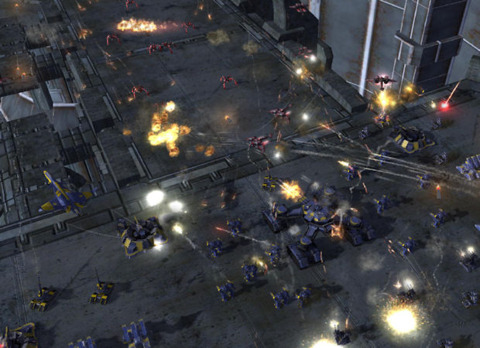Overview
Set 25 years after the events of the original game, Supreme Commander 2 begins with the assassination of the newly elected president of the Colonial Defense Coalition (CDC). The CDC members blame each other, and a galactic war ensues. Supreme Commander 2 places the character directly in control of this war. In the new campaings you are able to see a more emotion driven plot, as each campaign has its own family ties; a husband and wife, a father and son, a brother and sister. All of the campaigns are now canon.
The player will play the single-player campaign through the eyes of three commanders who befriended each other during their academy days:
Gameplay
 Hail to the King, baby
Hail to the King, baby Supreme Commander 2 preserves many of the key gameplay conceits of its
predecessor, but with several key changes. There is now also less complexity in the options players are given for base building and defense. The old Teir system for the fist game was scrapped, and all units were rebalanced accordingly. In the previous installment, experimental units were extremely difficult to build and extreamly difficult to destory. Experimentals have been rebalanced so that they are no longer game ending units. The combat has also become more fast paced, with units moving several times fater and building much quicker. The gameplay has been tweaked to be less unwieldy, quicker and tighter. The economy system from the first game, which only allowed you to have as much resources as you could store has been scrapped in favor of easier resoucrce management. This was done to make the game easier and to help newer players get into the game easier. Unit pathfinding has also been improved in this iteration, but moments of frustration can still arise when maneuvering units in built up areas.
Square Enix's Involvement
 Greater focus on constant sorties.
Greater focus on constant sorties. On November 12, 2008,
Square Enix announced a strategic partnership with
Gas Powered Games. Their role in the game's development is not entirely clear, but it's been said to be story-related. This is in line with their earlier acquisition of
Eidos and marks their continued will to further penetrate the Western gaming market.
Their influence is rather telling as the expositionary and storytelling style of the single player campaign is markedly JRPG-esque. Furthermore, character development of the protagonists in the campaign is better explored in this game than in its predecessor.
Differences from the First Game
Supreme Commander 2 represents quite a distinct departure from its predecessor. Most of these changes were designed to improve user control and accessibility by gentling the learning curve, which has upset some of the franchise's hardcore fans.
Gameplay/Balance
- Max unit cap lowered from 1000 to 500.
- Generally smaller maps designed to avoid the long drawn-out epic battles that characterized multiplayer in the first game
- No more tech tier levels for factories and engineers
- Introduction of the Research tree
- Research points are now a new resource (upgrades are immediately retrofitted onto existing units/structures)
- Less unit variety but this is arguably countered by the ability to continually upgrade units, making early game units stay relevant even in long, drawn-out engagements
- Units can be upgraded to fulfill multiple battlefield roles (a tank can be upgraded to have anti-air capabilities)
- No more reclaimable fields of mass (I.E. forests)
- Players are no longer able to queue up units for production if they do not have the resources to build the unit, however, one is still able to set factories to repeat building the current queue
- No more adjacency bonuses
- Engineers can no longer work together to build structures faster, and engineers assisting a factory while it is building have increasingly diminishing returns, the first engineer provides a 33% bonus to build speed, the second, 11%, the third, 1.1%, etc.
Unit Changes
- Removal of the Seraphim faction
- Experimentals are now produced by a factory, rather than being produced directly by the ACU or Engineers.
- The Aeon have been renamed to the Illuminate
- The Illuminate have no naval units but all their land units can hover in water
- Experimental units and structures are generally weaker than in the first game (The UEF Fatboy II being a notable example), but are more cost-effective
- All of the Experimentals from the original have been either redone (i.e. The Soul Ripper II and Fatboy II) or scrapped entirely in favor of new Experimentals.
Visual Presentation
- Graphics significantly improved across the board, individual units significantly more detailed.
- Game is no longer as demanding on GPUs as its predecessor was, and as a result the experience is more responsive and user friendly
Research System
 Research Tree
Research Tree The research tree in this game is much more traditional than the previous game's tech tiering and includes upgrades and add-ons for vehicles, and new unit unlocks.
Chris Taylor commented that this was done to solve the problem of how players of the previous game failed to see the value in their lower tiered units once they hit Tech 3 in the first game, as well as condensing the numerous units in the first into less, more versatile units.
There are now separate tech trees for land units, air units, naval units, structures and the ACU. Upgrades are increases in basic stats (e.g. speed, armor, firepower, build time, costs). Add-Ons add new weapons and functionality to units. Certain units must be unlocked through research before you are able to produce them. The research upgrades are able to turn the weakest of tanks into powerful units.
Research points (which are the game's third resource) are earned by building research stations. The gameplay implication of these changes is that there is a limited variety of units on the battlefield, as some can fill up to 4 roles.
Infinite War Map Pack DLC
Released on September 28th, 2010, the Infinite War Map Pack DLC expands Supreme Commander 2 with new maps for both the 360 and PC versions and new units, tech tree upgrades and improvements for the PC version.
4 player maps:
- Way Station Zeta
- Rigs
- EtchedDesert
- Seraphim Isles
- Igneous
- Tourneydome
2 player maps:
8 player maps (PC only):
- Tourneydome
- Ethced Desert
New units for the PC version:
- UEF Aegis: Experimental Shield Generator
- UEF Super Triton: Experimental Dreadnought
- UEF Jackhammer: Experimental Assault Artillery
- UEF Field Engineer: Mobile Repair and Support Unit
- UEF Research Converter: Research Conversion Facility
- Illuminate Sooprizer: Experimental Gunship
- Illuminate Illuminator: Experimental Intel Gathering Station
- Illuminate Buhbledow: Experimental Shield Destroyer
- Illuminate Shotja: Sniper Bot
- Cybran Monkeylord: Experimental Spider Bot
- Cybran Recycler: Mass Reclaimer
- Cybran Cicada: Experimental Cloak Generator
- Cybran Intellitron: Air Scout
- Cybran Boomerang: Nuclear Missile Defense
System Requirements
- OS: Windows XP/Vista/Windows 7
- Processor: 3.0 GHz or better, AMD or Intel CPU
- Memory: 1GB RAM (XP) 1.5GB RAM (Vista / Win 7)
- Graphics: 256 MB VRAM with Pixel Shader 3.0
- DirectX®: DirectX 9.0
- Hard Drive: 4-5 GB for full install & DirectX
- Sound: No accelerated sound hardware required
- Other requirements: Internet Connection with Cable / Broadband
Recommended System Requirements - OS: Windows XP/Vista/Windows 7
- Processor: 2.6 GHz or better, Dual Core AMD or Intel CPU
- Memory: 2GB RAM (XP) 2GB RAM (Vista / Win 7)
- Graphics: 256 MB VRAM DX9 compliant with Pixel Shader 3.0
- DirectX®: DirectX 9.0
- Hard Drive: 4-5 GB for full install & DirectX
- Sound: No accelerated sound hardware required
Log in to comment